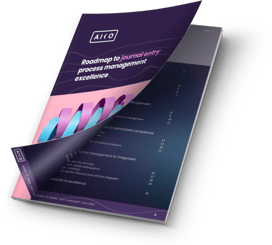Journal entry automation software can significantly reduce the manual and time-consuming tasks involved in creating and posting accounting journal entries. Automating these processes helps minimise errors, improve accuracy, and free up valuable time for finance teams to focus on more strategic tasks.
This software streamlines data entry, ensures compliance with accounting standards, and enhances overall efficiency, making it a paramount tool for modern finance departments.
The Old Way of Doing Journal Entries
When Aico was in its development stages, many companies manually entered journal entries into their ERP systems. Today, most use Excel imports to upload data from spreadsheets, but these imports often don't validate the data against the ERP. As a result, accountants spend time fixing issues.
This usually involves endless email exchanges, making it hard to track or control the process. Journal creators can’t be sure when the entry is posted, and approval is still often done manually, if it’s done at all. Auditing the process later can be difficult and time-consuming, often leading to paper journals and attachments being printed and archived.
When to Decide You Need a Journal Entry Automation Software
The following signs are typical for companies that would benefit from the intelligent journal process automation the most:
1. Average Monthly Number of Journals Exceeds 500
The first and most obvious reason for implementing purpose-built journal entry automation software is the volume. If your accounting team has to create and post at least 500 journal entries per month, your potential time saving with automation is 50%. Time-saving will be even more considerable if your journal entries mostly contain a single general ledger (GL) document number with multiple lines.
2. Hard Copies of Journal Entries are Kept in Binders

Consider implementing journal entry automation software if you are still printing and archiving your journals and supporting evidence in binders. A purpose-built journal entry software like Aico allows you to create, post and approve all your journal postings digitally. Once the journal entry is posted, the software will archive it with supporting evidence for fast and easy access.
3. Little to no Means to Validate Journal Entries
There are no or very few means to validate journal entry data before posting journals into the general ledger. With journal entry automation software, you can’t utilise active values from your ERP system’s value sets when posting and you don’t know if the values in the previous month’s Excel file are valid anymore. If there is something wrong with the posting, the accountant will find it out when trying to upload the journal through the Excel interface or enter it manually.
4. Journals are Posted to GL Manually or Through Excell

This is an error-prone and slow way to enter data. User interfaces of ERP systems are often not very useful either. The Excel upload interface provides a way to get data in, but if there are validation errors, manual work is required to fix postings (and in the worst case, the Excel file must be sent back to the creator) and all file handling is manual. If a journal recurs monthly, you must manually create a journal for every month and then upload it.
5. Multiple ERP Systems in Use
You have multiple ERP systems or multiple instances of an ERP system (most commonly SAP, Oracle, Microsoft, Agresso, Visma, and IFS). You must know by heart which ERP system various companies work, what the segments are in each system, and where to send the journal when it is ready. Journal entry automation software like Aico can hide the system complexity and retrieve some of the input data directly from your ERP systems.
6. Managing Journals via Emails

You have no or very little means of keeping track of the overall journal process. Emails are being sent back and forth within the team to check the status or to speed up the process. The roles for creating, approving, and handling journals might be agreed upon, but there is no real control of the process or real-time monitoring.
7. Existing RPA Solution in Place
Your company already utilises RPA (Robotic Process Automation) solutions for specific tasks, but you lack control and knowledge of how they work. In some cases, if the data is not valid, the RPA process stops and you must roll up your sleeves and dig into it yourself to keep the process going.
If you can identify these signs in your journal entry process, your company is probably losing a lot of time and resources on processing and managing a large number of tasks manually. By applying intelligent automation, your company can create, manage, and process journals accurately and fast.
At Aico, we have designed an intelligent automation tool that optimises every step of the journal process. Here is a summary of how Aico solves journal entry-related problems.
Add Transparency to the Journal Entry Management Process
Effective journal management and automation are making all the difference. API integrations allow the Aico solution to connect to multiple instances of the same (or different ERP) systems simultaneously, which allows the user to manage the complete set of journals live. Many additional features help to tackle risks, especially during the close process. Look for yourself:
- Templates support the creation of many standardized journals with as many lines as required. The templates enforce standardisation, preventing formatting errors.
- Correctly configured templates can save you a lot of time. For example, Aico enables easy posting of recurring journals, provisions and allocations. Workflow automation can create fully automated workflows for most standard (and not only) journaling scenarios.
- Recurring journal templates are the fastest way to save time. Many period-end postings have a recurring basis, and Aico provides the ability to create recurring journals that will automatically attach recurring supporting documents and work in a simple and predictable pattern.
Approvals and hierarchy management enable financial management to give just as much control over their finance teams as needed. Pre-set rules tell the end-user what journal entries can be created automatically and what kind of records demand supporting evidence, whether it be a document or just a comment. A flexible approval system enables the financial management team to impose company policies at every step of the journal management and financial closing process.
Automated journal entries can make the whole finance team’s calendar look much more like those who work 9-5 and have normal weekends throughout the month.
How does Aico Tackle The Inefficiencies?
Aico offers one seamlessly interconnected platform, allowing users to create journals, request journal creation, validate them, and, when necessary, pass them to the next person in the approval workflow, all within a single environment. This eliminates the need to rely on multiple systems and tools. Aico is a comprehensive solution that directly imports journals into your ERP system, enabling true journal entry automation.
Aico also streamlines the process with bulk uploading. Many enterprises still manage large, unwieldy Excel spreadsheets, but with Aico, users can upload spreadsheets containing thousands of rows of data, automatically populating all relevant journals. Additionally, Aico is highly configurable, allowing it to be tailored to fit any process. Standardising processes globally ensures internal controls are maintained.
- One interconnected platform for journal creation, validation, and approval
- Bulk uploading of large spreadsheets to pre-populate journals
- Highly configurable to fit any business process and ensure global standardisation
With Aico's journal entry automation, companies can achieve greater efficiency, control, and accuracy in their journal entry processes, streamlining workflows and reducing manual errors.
Conclusion
In conclusion, journal entry automation provides businesses with a powerful way to enhance efficiency and scalability. Streamlining the entire journal entry process, from creation and validation to approval, helps eliminate manual errors, reduce administrative burden, and maintain consistency.
With the ability to handle large volumes of data quickly and accurately, automation allows businesses to scale operations without sacrificing accuracy or control. Adopting journal entry automation boosts productivity and sets the foundation for more efficient and scalable financial processes moving forward.
Frequently Asked Questions
Is It Possible to Post Journal Entries Automatically?
Yes, with journal entry automation software, you can automate the entire process of posting journal entries, including validation, approval, and posting, all within your ERP system. This eliminates manual effort, reduces errors, and improves efficiency.
What is the Difference Between Automatic and Manual Journal Entry?
Automatic journal entries are generated and posted through software, reducing human input and errors. Manual entries require accountants to input data manually, which can be time-consuming, error-prone, and difficult to track compared to automated processes.
Can I Automate Accounting?
Yes, accounting processes can be automated using various software solutions. Automation can handle tasks like journal entries, reconciliations, financial reporting, and compliance, saving time, reducing errors, and improving accuracy in financial operations.
FURTHER READING:



